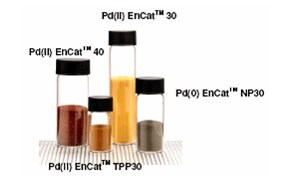Inorganic Catalysts

Inorganic catalysts, also known as heterogeneous catalysts, include metals and their oxides, supported on porous materials, that emulate the exquisite function of Nature′s catalysts― enzymes. The reactants bind to the active sites on the metal surface through adsorption. Hence it is important to ensure that there are sufficient active sites available on the metal surface. Porous materials, typically carbon, silica, or alumina, are chosen as supporting materials due to their large surface areas. As the surface area increases, the number of active sites increases and so does the catalytic activity.
Inorganic catalysts play a key role in many synthetic reactions in industry and academia. Because these catalysts are in a different phase than the starting materials and the desired compound (once the reaction is complete), they are easier to remove and recycle. This has made inorganic catalysts extremely valuable for industrial and bulk procedures. However, unlike the organocatalysts and ligands, heterogeneous catalysts aren’t easily optimized.
Products
Within the field of heterogeneous catalysis, there are several classes of transformations that have become a mainstay in the toolkit of synthetic and increasingly non-synthetic chemists alike. While several of these transformations are mentioned, they have taken the names of the laboratories from which they have been developed and include but are not limited to: Stille coupling, Buchwald-Hartwig, Negishi coupling, Heck reaction, Miyaura-Suzuki coupling, and Sonogashira coupling.
We offer an unmatched portfolio of inorganic catalysts such as platinum, palladium, ruthenium, rhodium supported on carbon, silica, and calcium carbonate to support all your research application needs. Just filter by keyword below.
Related Product Resources
Article: EnCat™ & Other Catalysts
Article: Heterogeneous Catalysts for Synthetic Applications
To continue reading please sign in or create an account.
Don't Have An Account?